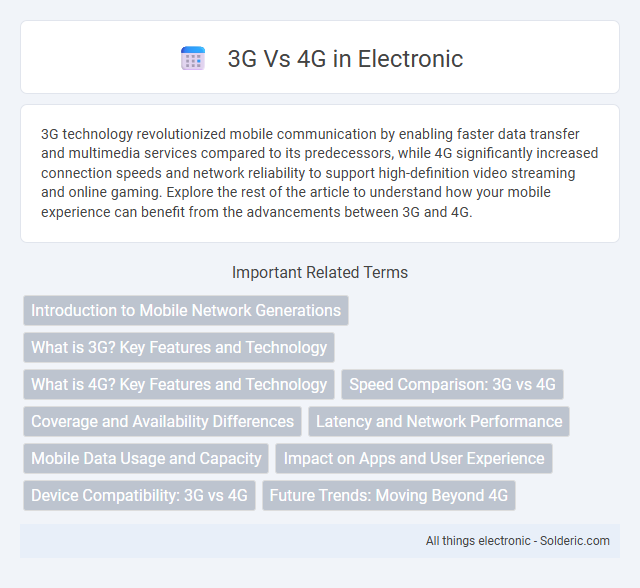3G technology revolutionized mobile communication by enabling faster data transfer and multimedia services compared to its predecessors, while 4G significantly increased connection speeds and network reliability to support high-definition video streaming and online gaming. Explore the rest of the article to understand how your mobile experience can benefit from the advancements between 3G and 4G.
Comparison Table
| Feature | 3G | 4G |
|---|---|---|
| Speed | Up to 3.1 Mbps | Up to 1 Gbps |
| Technology | UMTS, HSPA | LTE, WiMAX |
| Latency | 100-500 ms | 20-30 ms |
| Frequency Bands | Various 850/900/1900/2100 MHz | Various 700/800/1800/2600 MHz |
| Voice Support | Traditional Circuit Switching | VoLTE (Voice over LTE) |
| Application Support | Basic mobile internet, video calls | HD streaming, gaming, advanced apps |
| Deployment | Early 2000s | 2010s onwards |
Introduction to Mobile Network Generations
3G networks introduced mobile broadband, enabling faster internet access and multimedia services compared to 2G, with speeds up to several Mbps. 4G technology significantly increased data rates, reaching peak speeds of 100 Mbps to 1 Gbps, supporting HD video streaming, online gaming, and improved IP-based communication. These advancements underpin the evolution of mobile networks, enhancing connectivity, capacity, and user experience globally.
What is 3G? Key Features and Technology
3G, or third-generation mobile network technology, introduced faster data transmission speeds and improved voice quality compared to earlier 2G networks, enabling advanced services like mobile internet, video calling, and mobile TV. Key features of 3G include data rates up to 2 Mbps, support for IP-based multimedia services, and enhanced network capacity using technologies such as WCDMA (Wideband Code Division Multiple Access) and CDMA2000. This generation marked a significant shift toward broadband capabilities in cellular communication, laying the foundation for subsequent 4G advancements.
What is 4G? Key Features and Technology
4G is the fourth generation of mobile network technology designed to provide faster internet speeds and improved connectivity compared to 3G. It supports high-definition video streaming, seamless video calls, and enhanced gaming experiences through technologies like LTE (Long-Term Evolution) and OFDM (Orthogonal Frequency-Division Multiplexing). With 4G, your mobile device achieves download speeds up to 100 Mbps, enabling more efficient data transfer and lower latency for better overall performance.
Speed Comparison: 3G vs 4G
4G networks offer significantly faster speeds than 3G, with average download rates of 20-100 Mbps compared to 3G's typical 1-5 Mbps range. This speed enhancement allows smoother streaming, quicker downloads, and improved real-time gaming experiences. Upgrading to 4G will dramatically improve Your mobile internet performance and connectivity.
Coverage and Availability Differences
3G networks offer wider coverage in rural and remote areas due to their lower frequency bands and established infrastructure, enabling consistent connectivity where newer technologies are limited. 4G networks utilize higher frequency bands that provide faster data speeds but often require denser cell tower placement, resulting in superior coverage primarily in urban and suburban regions. The transition to 4G improves overall network capacity and availability in populated areas but may leave gaps in coverage outside major cities.
Latency and Network Performance
4G networks significantly reduce latency compared to 3G, offering response times as low as 30-50 milliseconds versus 100-500 milliseconds in 3G, which enhances real-time applications like video calls and online gaming. Network performance in 4G is vastly superior due to higher bandwidth and improved spectral efficiency, enabling faster data transfer speeds up to 100 Mbps or more, compared to 3G speeds of around 2 Mbps. Your mobile experience benefits from smoother streaming, quicker downloads, and more reliable connectivity with 4G's advanced infrastructure.
Mobile Data Usage and Capacity
4G networks offer significantly higher mobile data usage capacity compared to 3G, enabling faster download and upload speeds essential for streaming, gaming, and video calls. You can experience lower latency and greater network efficiency with 4G, supporting more simultaneous users without compromising performance. This enhanced capacity makes 4G ideal for modern mobile applications requiring large data transfers and continuous connectivity.
Impact on Apps and User Experience
4G networks dramatically enhance app performance by offering higher data speeds and lower latency compared to 3G, enabling smoother video streaming, faster downloads, and real-time gaming. Your mobile apps can leverage 4G's increased bandwidth to support richer multimedia content and improved cloud-based services, resulting in a more responsive and immersive user experience. Developers optimize apps for 4G to deliver advanced features that are often limited or impractical on 3G connections.
Device Compatibility: 3G vs 4G
3G networks support older devices with basic data capabilities, enabling voice calls and moderate internet access, while 4G networks require more advanced hardware designed for high-speed data transmission and seamless multimedia streaming. Device compatibility for 4G includes smartphones, tablets, and IoT devices with LTE or LTE-A support, offering enhanced performance compared to 3G-compatible devices. As carriers phase out 3G infrastructure, maintaining device compatibility with 4G becomes essential for uninterrupted connectivity and access to modern applications.
Future Trends: Moving Beyond 4G
Future trends in mobile networks are rapidly evolving beyond 4G, with 5G technology promising significantly higher data speeds, ultra-low latency, and enhanced connectivity for IoT devices. The shift from 3G to 4G introduced LTE and mobile broadband, but 5G expands capabilities to support smart cities, autonomous vehicles, and immersive AR/VR experiences. Your digital experience will dramatically improve as operators deploy 5G networks that enable seamless communication and advanced applications.
3G vs 4G Infographic

 solderic.com
solderic.com